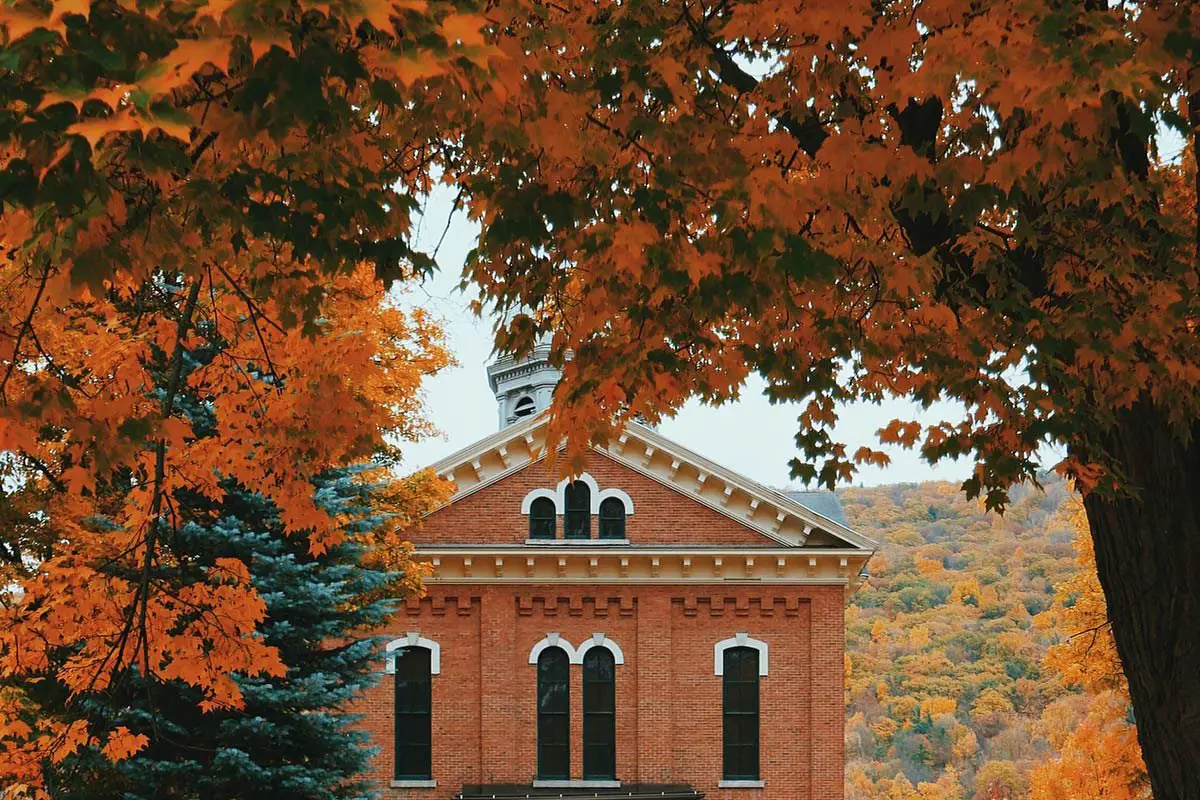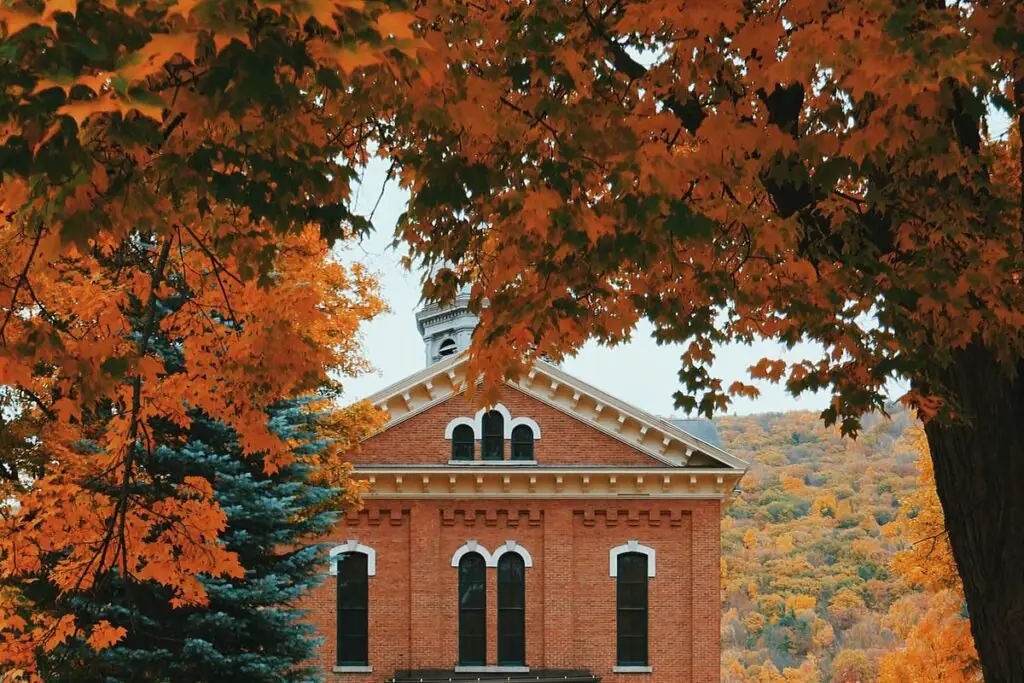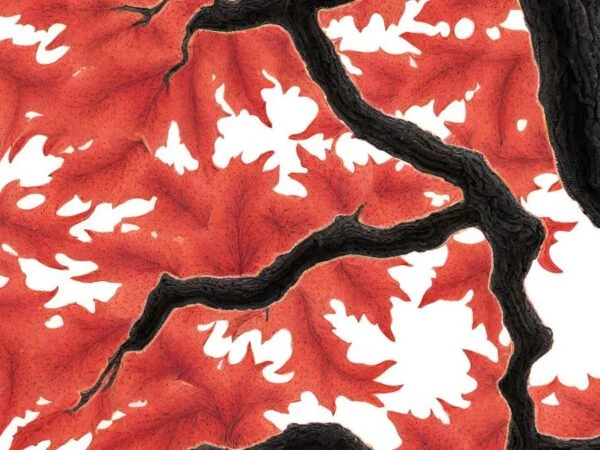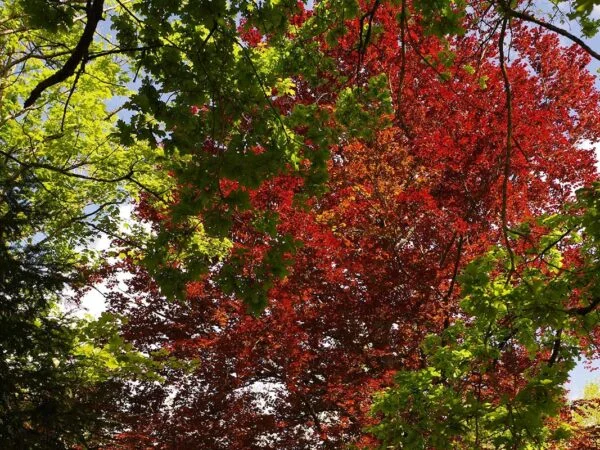
Did you know that the golden goodness of maple syrup starts with a humble sap? For centuries, people have been collecting sap from maple trees to create this sweet treat. But have you ever wondered how much sap a maple tree can produce? Well, it turns out that the answer depends on various factors like the type of tree, weather conditions, and the sugar content of the leaves.

Maple tree sap production is a fascinating process that involves extracting sap from maple trees. This liquid gold is then boiled down to create syrup with high sugar content. The process requires patience and precision, as the sap needs to be collected and boiled until the desired consistency is reached. By understanding the intricacies of evaporation and the role of leaves in the sap production process, you'll gain a deeper appreciation for every drop of syrup that graces your pancakes or waffles.
So, grab your stack of fluffy goodness and join us as we explore the captivating world of maple tree sap production. Get ready to be amazed by nature's sweetest gift - maples! Discover how they produce sap with high sugar content, which is then transformed into finished syrup.
Average sap yield of a maple tree
Maple trees, especially sugar maples, are well-known for their ability to produce sweet sap that is used to make maple syrup. But how much sap does a maple tree produce? Let's explore the average sap yield of a maple tree and the factors that can influence it.
On average, a mature maple tree can produce around 10 to 20 gallons of sap per season. However, it's important to note that this number can vary depending on various factors such as the size and health of the tree. Larger and healthier trees tend to have higher sap yields compared to smaller or weaker ones. The sap is used to make finished syrup, which has a specific sugar content.
The amount of sap produced by a maple tree is influenced by several key factors, including temperature fluctuations. Freeze-thaw cycles, when temperatures rise above freezing during the day but drop below freezing at night, stimulate the movement of sap within the tree. This process creates an ideal environment for sap flow.
Sunlight exposure also plays a crucial role in determining the amount of sap a maple leaf tree produces. Trees situated in areas with ample sunlight tend to have higher sugar content in their sap and therefore produce more syrup-worthy liquid. Sunlight helps stimulate photosynthesis, allowing trees to convert sunlight into energy-rich sugars stored in their trunks and roots. The temperature of the water can also affect the production of sap from the spout.
Tapping sugar maple, silver maple, and black maple trees responsibly is essential for ensuring the long-term health and sustainable production of quality sap. It's vital not to over-tap or tap too many holes into the trunk of these maple species as this can weaken the tree and potentially cause irreversible damage. The general rule of thumb is not tapping more than one tap hole per 10 inches diameter at chest height.
To maximize sap yield while maintaining the health of sugar maple, silver maple, and black maple trees, it's recommended to follow these best practices for tapping maple species.
- Choose healthy trees: Select mature sugar maples that have healthy leaves and are free from diseases or signs of stress. Use water to keep the trees hydrated and ensure optimal growth.
- Tap at the right time: Start tapping when temperatures consistently fluctuate between freezing and thawing, reaching around 32 degrees Fahrenheit. This is when the water in the maple sap begins to boil and can be collected for syrup production.
- Proper tapping technique: Use clean, sanitized equipment and tap trees with a spout at a slight upward angle to allow water sap to flow freely, like wine from a maple leaf.
- Regularly check the collection buckets or tubing system to ensure proper sap collection from the sugar maple tree without any leaks or blockages. Monitor the flow of water to make sure it is flowing smoothly through the spout.
- Remove maple sap taps promptly: Once the sugaring season is over, remove maple sap taps promptly to minimize damage to the leaf.
Tapping maple trees for sap: Process and techniques
Tapping a maple tree is a fascinating process that allows us to extract the sweet sap hidden within these magnificent trees. By drilling a small hole into the trunk of a sugar maple or black maple, we can tap into this natural resource and collect the sap for various purposes, such as boiling it in a pan to make maple syrup. Let's explore the process and techniques involved in tapping maple trees and the water needed for boiling the sap.
Tapping Technique: Extracting Tree Sap
To begin the tapping process, you will need to carefully drill a small hole into the tree trunk using a specialized drill bit. This tap hole should be positioned at just the right height and angle in order to ensure optimal sap flow without causing harm to the tree. It is important to use a healthy tree with a robust trunk, as they are more likely to produce an ample amount of sap.
Once the tap hole has been created in a single tree, a spout or spile is inserted into it. This spout acts as a conduit through which the collected sap can flow freely into a collection container such as buckets or plastic tubing systems. The size and design of the spout may vary depending on personal preference and equipment used for boiling the sap in a pan.
Maximizing Sap Flow: Proper Techniques
To maximize sap flow while minimizing damage to the tree, it is essential to use proper tapping techniques. Here are some key points to consider: boiling the sap in a pan to condense it, using the right amount of heat, and figuring out the optimal time to tap the tree.
- Tree Selection: Choose mature sugar maples or black maples with healthy wood and abundant foliage. These trees have higher sugar content in their sap.
- Tap Placement: Position taps on different sides of the tree, evenly spaced apart, allowing each tap hole sufficient time to heal before re-tapping in subsequent years.
- Drill Size: Use an appropriate drill bit size that matches your chosen spout diameter.
- Tap Depth: Drill holes at a depth that reaches just inside the outermost layer of wood beneath the bark.
- Avoid Dead Wood: Avoid tapping areas with dead wood, as it may hinder sap flow and compromise the health of the tree.
Maintenance and Monitoring: Ensuring Success
Tapping maple trees is not a one-time event; it requires regular maintenance and monitoring throughout the sugaring season. Here are some important tasks to keep in mind when using a pan to collect the sap and figure out the best time to tap the trees.
- Check Sap Collection: Regularly inspect collection containers to ensure they are clean, properly positioned, and free from any debris.
- Monitor Sap Flow: Keep an eye on the amount of sap collected daily. This will help determine when to empty containers and whether adjustments need to be made in tapping techniques.
- Inspect Tap Holes: Periodically examine tap holes for signs of damage or infection. If necessary, sanitize tap holes with alcohol or bleach solution before re-tapping.
From Sap to Syrup: The Evaporation and Boiling Process
Once you have collected enough sap, it's time to transform it into delicious maple syrup through the process of evaporation and boiling. Here's a simplified overview of this figure.
- Evaporation: Transfer the collected sap into an evaporator—a specialized device designed to remove excess water from the sap. As the sap boils, steam rises while concentrated liquid remains.
- Boiling: Continue boiling the concentrated sap until it reaches a specific density known as "syrup density." This can be determined using a hydrometer or by observing its consistency on a spoon.
Timing and Seasonality of Tapping for Maximum Sap Collection
Tapping maple trees to collect sap is a time-sensitive process that requires careful consideration of the timing and seasonality. By tapping the tree at the right moment, you can maximize your sap collection and ensure a successful sugaring season.
1. Tapping should be done in late winter or early spring when temperatures fluctuate above freezing during the day but still drop below freezing at night.
Timing is crucial. Late winter or early spring, typically between February and March, provides the ideal conditions for sap flow. During this period, temperatures begin to rise during the day while still dipping below freezing at night.
2. This period triggers changes in pressure within the tree, causing increased sap flow.
The fluctuation in temperature creates a pressure gradient within the maple tree, driving the sap to flow more vigorously. As temperatures rise during the day, pressure builds up inside the tree's vessels, pushing out sap through any openings created by tapping.
3. The sugaring season typically lasts 4 to 6 weeks, depending on regional climate variations.
The duration of the sugaring season varies from region to region due to differences in climate patterns. In some areas with milder climates, such as parts of southern Canada and northern United States, it may start as early as February and last until April. However, in colder regions further north, it might begin later and end sooner.
4. Monitoring weather patterns helps determine optimal timing for tapping and maximizing overall syrup production.
To make the most of your maple syrup production, keeping an eye on weather patterns is essential. Regularly checking local forecasts will help you identify periods with consistent freeze-thaw cycles—the key driver of sap flow—and decide when to tap your trees.
By aligning your tapping efforts with favorable weather conditions characterized by daytime temperatures above freezing (around 40-50°F or 4-10°C) and nighttime temperatures below freezing (around 20-30°F or -6 to -1°C), you can optimize sap collection.
Maximizing sap collection efficiency through proper tapping techniques
Tapping multiple trees within close proximity allows for efficient collection using fewer resources.
One important technique is tapping multiple maple trees that are located close to each other. By doing so, you can streamline the collection process and minimize the resources required. Instead of setting up individual taps for each tree, you can connect them with a series of tubing or pipelines, allowing the sap to flow directly into a central container.
This method offers several advantages. Firstly, it reduces the need for multiple buckets or containers, which can be cumbersome and time-consuming to empty. By consolidating the sap from several trees into one central point, you simplify the collection process and minimize the effort required to transport and store the sap.
Properly cleaning equipment between taps reduces contamination risks and maintains high-quality sap.
Maintaining cleanliness throughout the tapping process is crucial to ensure high-quality sap production. Before moving from one tree to another, it is essential to clean your equipment thoroughly. This includes sterilizing spouts and buckets or containers used in collecting sap.
Contamination risks arise when residual bacteria or debris from previous taps mix with fresh sap. Such contaminants can affect both the taste and quality of maple syrup produced from this sap. To avoid this issue, make sure to wash all equipment with hot water and mild soap before reusing it on another tree.
Using the appropriate size of spout and ensuring a secure fit helps optimize sap flow.
The size of the spout used for tapping plays a significant role in determining how efficiently sap flows from a maple tree. Choosing an appropriate-sized tap ensures that there is enough space for optimal fluid movement without causing unnecessary damage to the tree's bark.
It is recommended to use smaller spouts (commonly known as "taps") for young trees since they have thinner trunks compared to mature ones. For larger trees, bigger taps can be employed to accommodate the higher sap flow rates. Ensuring a secure fit between the spout and tree bark is crucial to prevent leaks and maximize sap collection.
Regularly checking and adjusting taps throughout the season ensures consistent collection efficiency.
To maintain consistent sap flow and maximize collection efficiency, it is essential to regularly monitor and adjust your taps throughout the maple syrup season. Sap flow can vary depending on weather conditions, tree health, and other factors. By regularly inspecting your taps, you can identify any issues that may impede optimal sap collection.
If you notice a decline in sap flow from a particular tap, it may indicate an obstruction or damage to the spout. In such cases, cleaning or replacing the tap can help restore efficient sap flow. Regularly adjusting taps based on observed changes in sap production ensures that you make the most of each tree's potential throughout the entire maple syrup season.
By implementing these tapping techniques – tapping multiple trees within close proximity, cleaning equipment between taps, using appropriate-sized spouts with secure fits, and regularly checking and adjusting taps – you can significantly enhance your maple tree's sap collection efficiency. This not only allows for greater productivity but also helps maintain high-quality sap for producing delicious maple syrup.
Potential syrup yield from a single maple tree each year
Maple syrup is a delicious and popular sweetener made from the sap of maple trees. Have you ever wondered how much sap a maple tree can produce, and how that translates into syrup?
On average, it takes around 40 gallons of sap to produce one gallon of maple syrup. This means that for every 40 gallons of sap collected from a maple tree, you can expect to obtain approximately one gallon of pure, golden goodness. However, it's important to note that this ratio can vary depending on factors such as weather conditions and the sugar content in the sap.
A mature maple tree has the potential to yield enough sap to produce 1 to 2 quarts of syrup per season. The sugar content in the sap plays a crucial role in determining the quality and flavor profile of the resulting syrup. The higher the sugar concentration in the sap, the sweeter and more flavorful the syrup will be.
Tapping multiple trees not only increases overall syrup production but also distributes the workload across different trees. By tapping several trees instead of relying solely on one, you can maximize your yield while ensuring that no single tree is overburdened.
To tap a maple tree effectively, consider its size and diameter. A general rule of thumb is that a tree should have a diameter of at least 10 inches before tapping. This ensures that there is sufficient flow through its vascular system without causing harm or stress. Larger trees are capable of producing more sap than smaller ones due to their increased capacity.
When tapping multiple trees, it's essential to calculate how many taps each tree can handle based on its size. As an estimate, you can use one tap for every 10-12 inches in diameter. For example, if you have a maple tree with a diameter of 20 inches, it can accommodate two taps.
The amount of sap a maple tree produces can also be influenced by environmental factors such as sunlight exposure and soil conditions. Trees located in areas with abundant sunlight tend to produce more sap compared to those in shaded regions. Similarly, well-drained soil promotes healthier root systems, leading to increased sap production.
To collect the sap efficiently, you will need containers such as buckets or plastic bags that are specifically designed for maple syrup collection. These containers should be placed securely on the taps to catch the dripping sap. It's important to check these containers regularly and empty them into larger storage containers to prevent overflow.
Once you have collected an adequate amount of sap, it's time for the transformation process. The collected sap needs to be boiled down until it reaches the desired consistency and sweetness. This is typically done by evaporating the excess water content through continuous boiling.
During this process, the sap undergoes a significant reduction in volume due to evaporation. The boiling point of maple syrup is around 219 degrees Fahrenheit (104 degrees Celsius). As the water content decreases, the sugar concentration increases, resulting in a thicker and richer syrup.
Storing homemade syrup: Tips for preservation and shelf life
Homemade maple syrup is a delightful treat that captures the essence of nature's sweetness. To ensure its quality and longevity, it is essential to store it properly. Here are some tips on how to preserve your homemade syrup and extend its shelf life.
Sterilized Glass Containers with Tight-Fitting Lids
Using sterilized glass containers with tight-fitting lids is crucial. Glass containers are ideal because they do not react with the syrup, ensuring that its flavor remains intact. Before transferring the syrup into the containers, make sure they are thoroughly cleaned and sterilized to prevent any contamination.
Refrigeration for Freshness
Once you have opened a container of homemade maple syrup, refrigeration becomes necessary to maintain its freshness. The cool temperature helps inhibit bacterial growth and prevents spoilage. By refrigerating your syrup after opening, you can enjoy its delectable taste for an extended period.
Preserving in Cool, Dark Places
If you haven't opened your homemade maple syrup yet, storing it in cool, dark places can significantly extend its shelf life. Find a spot away from direct sunlight or heat sources like stoves or radiators. A pantry or cellar works well for preserving the quality of your syrup over time.
Inspecting for Mold or Fermentation
Before consuming stored homemade maple syrup, always inspect it carefully for signs of mold or fermentation. Even though proper storage techniques help prevent these issues, it's essential to remain vigilant. If you notice any unusual colors, textures, or off-putting odors in the syrup, discard it immediately as consuming spoiled food can be harmful.
Remember these tips when storing your homemade maple syrup:
- Use sterilized glass containers with tight-fitting lids.
- Refrigerate opened bottles.
- Store unopened bottles in cool, dark places.
- Inspect for mold or fermentation before consumption.
By following these guidelines, you can savor the delectable taste of your homemade syrup for up to a year or even longer. Enjoy the fruits of your labor and relish the natural sweetness of maple in every drop!
So, whether you are tapping into the syrup production process as a hobby or creating it at home for personal use, ensuring proper storage is essential. Take pride in knowing that your efforts have resulted in a delectable syrup that can be enjoyed throughout the year.
Unlocking the Full Potential of Maple Tree Sap
In conclusion, tapping maple trees for sap can unlock the full potential of this natural resource. By understanding the average sap yield of a maple tree and implementing proper tapping techniques, you can maximize your sap collection efficiency. Timing and seasonality also play a crucial role in ensuring optimal sap collection.
Through careful tapping and collection, you have the potential to yield a significant amount of syrup from a single maple tree each year. This homemade syrup can be stored using preservation tips to extend its shelf life.
To fully enjoy the benefits of maple tree sap, consider incorporating it into your culinary creations or sharing it with family and friends. The possibilities are endless.
Unlocking the full potential of maple tree sap requires knowledge, patience, and dedication. With the right techniques and timing, you can tap into nature's sweetest offering.
FAQs: How Much Sap Does a Maple Tree Produce?
How do I tap a maple tree for sap?
To tap a maple tree for sap, follow these steps:
- Identify mature maple trees.
- Drill a hole at chest height on the south-facing side of the trunk.
- Insert a spile or tap into the hole.
- Hang a bucket or attach tubing to collect the dripping sap.
- Monitor regularly and collect sap as needed.
What is the best time to tap a maple tree?
The best time to tap a maple tree is during late winter or early spring when temperatures fluctuate between freezing at night and thawing during the day.
How long does it take for sap to flow after tapping?
After tapping, it typically takes 24-48 hours for sap to start flowing from the tree.
Can I use any type of container to collect maple tree sap?
While traditional metal buckets are commonly used, you can also use food-grade plastic containers or tubing systems designed specifically for collecting sap.
How long can homemade maple syrup be stored?
When properly stored, homemade maple syrup can last up to one year. It is essential to keep it in a cool, dark place and ensure the container is tightly sealed.
These FAQs should provide you with valuable information to get started on your maple tree sap journey. Happy tapping!
Image Source: Paid image from CANVA





